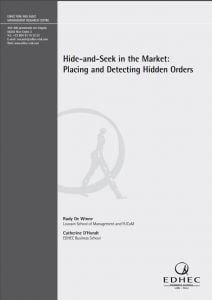

Hide-and-Seek in the Market : Placing and Detecting Hidden Orders
This paper investigates why traders hide their orders and how other traders respond to hidden depth. Using a logit model, the authors provide empirical findings suggesting that traders use hidden orders to manage both exposure risk and picking off risk. Using probit models, they show that hidden depth increases order aggressiveness. The authors' interpretation of this empirical evidence is threefold. First, hidden depth detection is possible and frequent. Second, when traders detect hidden volume at the best opposite quote, they strategically adjust their order submission to seize the opportunity for depth improvement. A revisited version of this paper was published in the September 2007 issue of Review of Finance (formerly European Finance Review).
Author(s):
Summary:
This paper investigates why traders hide their orders and how other traders respond to hidden depth. Using a logit model, the authors provide empirical findings suggesting that traders use hidden orders to manage both exposure risk and picking off risk. Using probit models, they show that hidden depth increases order aggressiveness. The authors' interpretation of this empirical evidence is threefold. First, hidden depth detection is possible and frequent. Second, when traders detect hidden volume at the best opposite quote, they strategically adjust their order submission to seize the opportunity for depth improvement. A revisited version of this paper was published in the September 2007 issue of Review of Finance (formerly European Finance Review).
Register to download PDF
Register/Log in| Type : | Working paper |
|---|---|
| Date : | 14/10/2007 |
| Keywords : |
Order Execution |

